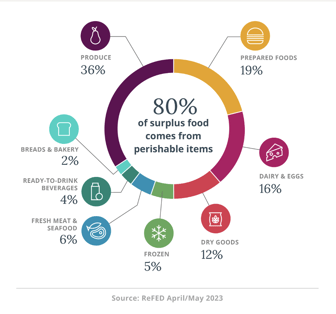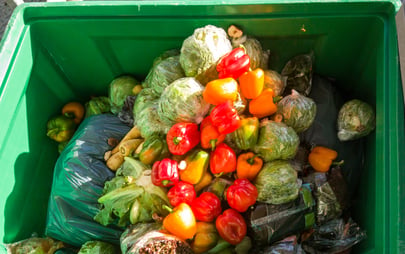 The statistics regarding food waste are staggering - and frankly, they can be a bit depressing. Food waste is an issue of enormous scale with far-reaching humanitarian, environmental and economic consequences that will only continue to compound as the global population grows.
The statistics regarding food waste are staggering - and frankly, they can be a bit depressing. Food waste is an issue of enormous scale with far-reaching humanitarian, environmental and economic consequences that will only continue to compound as the global population grows.
To put the enormity of this issue into perspective, in 2021, 38% of the US food supply went unsold or uneaten, equating to a cost of $444 billion, of which $310 billion was attributable to food waste. Each year, $149 billion meals worth of food goes unsold or uneaten in the US. Expand this globally, and it is estimated that 1.3 billion metric tons is wasted annually from farm to fork.
The Consequences of Food Waste
But it's not just the food that goes to waste - it's all of the resources throughout the supply chain used to produce, transport and store the food that get wasted from unnecessarily deforested land, to wasted fossil fuels, fertilizer, and water. It is estimated that 1/3 of all food grown for human consumption in the US never makes it to someone's stomach, which equates to 4 trillion tons of wasted water. All of these resources and the resulting carbon footprint of using them are just unnecessary if that food goes to waste. ReFED estimates that uneaten food consumes:
-
-
- 6% of US GHG emissions
- 22% of all fresh water use
- 16% of US cropland use
- 24% of landfill inputs
-
Not to mention the injustices of food waste and the potential for that food to impact food insecurity and world hunger, particularly considering that the majority of that "waste" is edible. Per the Economic Research Service in 2021 33 million, or 1 in 10, Americans lived in food-insecure households. In the Summer of 2022, 11.5% of people surveyed by the Census Bureau said that people in their household "sometimes" or "often" did not have enough to eat - which was an 8.2% increase from the year before.
In addition to providing food to those in need, reducing food waste can also help feed the world's growing population more sustainably. The United Nations predicts that by 2050, the world's population will require a 50% increase in food production from 2010 levels. Decreasing the amount of food that goes wasted each year can effectively open up additional "capacity" through more efficient consumption.
Amidst all of these daunting statistics we haven't even mentioned the significant environmental consequences of all this waste. For all of the pressure that the packaging industry experiences to improve sustainability, the average consumer may not realize that wasted food has a shockingly high greenhouse gas footprint. In fact, recent estimates of global annual greenhouse gas emissions rank emissions caused by food waste above emissions from the transportation and electricity sectors in the US combined.
When unused food sits in landfills it generates methane - a greenhouse gas 80 times stronger than carbon dioxide over a 20 year period - and food makes up the largest component (22%) of US waste in landfills. According to the EPA, food waste is responsible for roughly 8% of emissions, which comes as a result of not just the methane produced from decaying food, but from the accumulation of resources all along the supply chain from farm to table. Again, let's look at some statistics to help conceptualize the environmental consequences of food waste:
-
-
- The carbon footprint of U.S. food waste is greater than the airline industry
- Unused food in landfills contributes to 4% US GHG emissions - equivalent to the same emissions as 20% of the cars in the US
- 32.7 million tons of surplus food was sent to landfill in 2019, translating to nearly 23 million tons of CO2 emissions produced from landfill
- Food waste is responsible for 170 million metric tons of carbon dioxide equivalent GHG emissions - equivalent to the annual CO2 emissions of 42 coal-fired power plants
- Unsold & uneaten food is responsible for the same amount of GHG emissions as nearly 100 coal-fired power plants
-
How can packaging help combat food waste?
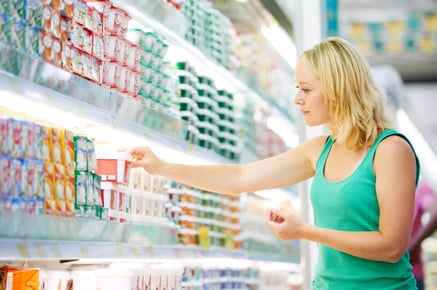 While these statistics regarding the consequences of wasted food are staggering, it also presents an enormous opportunity for packaging to help in a way that positively impacts our environment. ReFED’s food waste analysis estimates that an annual investment in food waste reduction strategies of $18 billion can reduce food waste by nearly 58 million tons each year, resulting in a $74 billion annual net financial benefit.
While these statistics regarding the consequences of wasted food are staggering, it also presents an enormous opportunity for packaging to help in a way that positively impacts our environment. ReFED’s food waste analysis estimates that an annual investment in food waste reduction strategies of $18 billion can reduce food waste by nearly 58 million tons each year, resulting in a $74 billion annual net financial benefit.
Quantified in terms of environmental benefits, this would lead to a 109-million-ton reduction in greenhouse gas emissions – the same as taking 24 million gas-powered cars off the road – not to mention saving 6 trillion gallons of water and recover 4.3 billion meals that could be given to those in need. Additionally, EPA research indicates that diverting food waste from landfill reduces methane generation potential by 33%.
Negative Perceptions Leads to Underutilization
Studies on food waste reduction strategies show that prevention is the most impactful form of GHG reduction. Considering this, packaging is one of the most viable, economical and impactful tools available to help extend shelf-life, enhance product protection and ultimately reduce food waste within our global food system.
A 2018 study conducted by the American Institute for Packaging and the Environment (AMERIPEN) titled "Quantifying the Value of Packaging as a Strategy to Prevent Food Waste in America" cites that packaging, in comparison to other food waste reduction techniques, results in six times more GHG emissions savings than composting, seven times more than anaerobic digestion and three times more than redistribution. Additionally, systems & supply chains for the production and reclamation of packaging, while there may be room for improvement, are already in place making it a more feasible strategy from an implementation perspective. Unfortunately, the potential of packaging’s role in food waste prevention is often overlooked due to the perceived negative impact on the environment as a result of its single-use nature and high visibility of waste.
When it comes to packaging, negative public perception often leads to attempts to remove or reduce packaging. However, this may have unintended negative consequences from a food waste perspective. This same study from AMERIPEN uncovered a correlation between foods with the highest percentage of waste and those with the least amount of packaging, highlighting the role that packaging can play in preserving food and extending shelf-life.
However, when surveyed, there was a clear disconnect between consumer understanding of the role packaging plays in food waste:
-
- 9 out of 10 consumers believe that packaging is worse for the environment than food waste
- 65% of consumers do not think that packaging helps avoid food waste
- Consumers widely shared the belief that unpackaged food is fresher and more nutritious than packaged food
- Only about 1/3 of consumers realized the shelf-life extension possibilities of packaging
As a result, packaging solutions that could otherwise be a key tool in combating the food waste crisis are often overlooked.
Where does food waste happen?
Before digging into strategies for how packaging can help combat the growing food waste problem, it helps to take a look at where the majority of food waste happens. According to ReFED, 48% food waste happens in the home while 20% happens in consumer-facing businesses including restaurants, grocery stores and other foodservice businesses. But from farm to fork and beyond, food loss and waste happens at all stages of the supply chain:
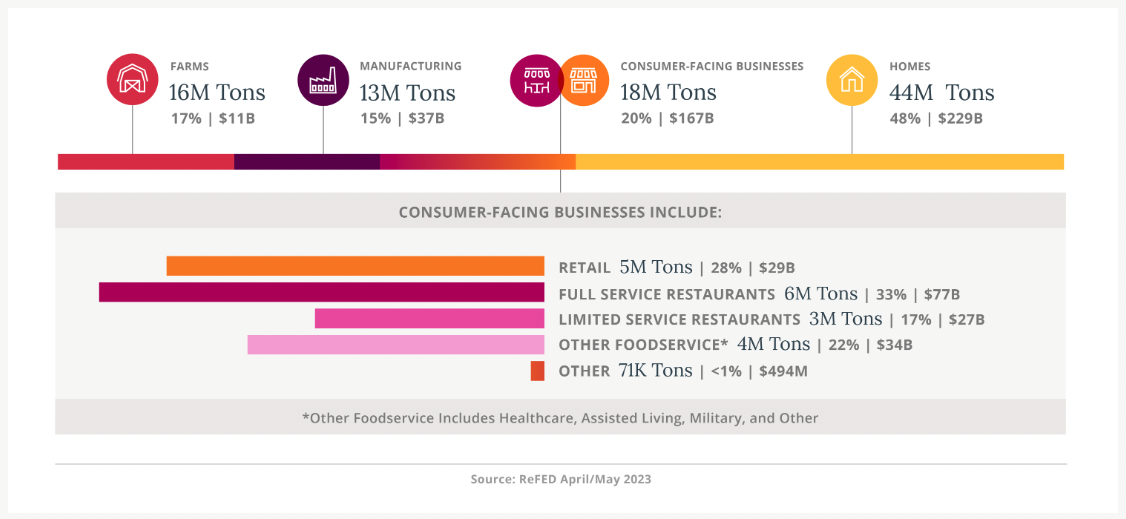
The already-complicated food production & distribution supply chain becomes even more complex when you consider the time-sensitive nature of many fresh products, retail quality standards, temperature control and safety requirements.
Unsurprisingly, much of this food waste comes from perishable items including fruits, vegetables, meats, prepared deli items, seafood, milk & dairy and some bread & bakery items. These items tend to "go bad" faster than non-perishable foods such as pastas, canned goods and other shelf-stable products such as baby food, which do not spoil as easily and/or are packaged in such a way preserve the product and extends shelf-life.
Turns out that aspirational bag of lettuce that you bought at the grocery store last week has an impact on more than just your ego!
Employing Packaging Technologies & Design Optimization as a Food Waste Reduction Strategy
Based on the above, it remains clear that packaging is an under-utilized solution when it comes to strategies for reducing food waste and curbing emissions. In fact, ReFED identified the optimization of packaging as one of the top three most effective solutions for reducing food waste in the US estimating that changes to packaging design can help divert 1.1 million tons of food waste annually, resulting in a 6 million metric tons reduction of CO2, which is equivalent to taking 1.3 million cars off the road per year.
There are several ways to optimize packaging through design and technology that can make a significant dent in the effort to combat food waste while also contributing a of financial, environmental and social benefits. In accordance with guidelines from ReFED and the Sustainable Packaging Coalition, some actionable strategies for rigid food packaging solutions are included below:
-
-
- Re-sealable or Re-closable Packaging:
For products that may not be consumed in one sitting or products easily susceptible to mold growth, re-sealable packaging may be a simple design upgrade that can go a long way in terms of food waste reduction and, as an added benefit, increased brand loyalty. Surveys show that consumers want more resealable and re-closable packaging particularly for product categories like meat, snacks and bakery. However, it is important to ensure that re-sealable or re-closable features such as zippers, lids or film don’t negatively impact recyclability. Using mono-material features such as a PP or PET lid compatible with the base structure where possible will help avoid the dreaded monstrous hybrid. - Packaging Size Optimization & Increased Size Variety:
Developing smaller sizes or adding more size variety for a product can reduce food waste in various ways by giving the consumer better control over portions. For certain rigid food packaging applications such as guacamole or hummus, a multi-pack containing 4-6 portion control recyclable PP packages may help reduce food waste in the home by enabling consumers to open a portion as-needed. ReFED’s Insights Engine estimates that portion sizing in foodservice would have a net financial benefit of $9 billion annually and is ranked as a top solution for emissions reduction and water savings. - Product Visibility:
Depending on the food product, designing packaging in a way that enables or prevents product visibility can help reduce food waste. For certain rigid packaging applications clear PP or PET could help give consumers insight into the quantity or quality (freshness) of the product. In consumer homes, this could help reduce food waste by either encouraging them to consume the product before it spoils or making them aware of the quantity remaining. In addition, at the retail level, when consumers can see into the package, they may be more likely to purchase the item. Conversely, some products that are UV sensitive would benefit from completely opaque packaging. - Improved Product Evacuation:
While food remaining at the bottom or sides of a used container may seem negligible, extrapolated over time, and compounded by the billions of people across the planet, residual food waste can quickly add up. It is estimated that leftover contents in a container may be as high as 15% for certain product categories such as condiments due to the viscous nature of the product and difficulty for consumers to access the full contents. Not to mention, food contamination in packaging can negatively impact recyclability of the packaging. ReFED estimates that packaging adjustments or designs that give consumers easy access to the contents and enable complete product evacuation can divert 280,000 tons of food waste with an economic value of $882 million annually. - Active Packaging:
Packaging technologies that assist in preservation can play a significant role in food waste prevention. ReFED estimates that active and intelligent packaging can help divert 1.1 million tons of food waste & save 314 billion gallons of water. Active packaging includes packaging technologies that can slow spoilage and the extend shelf-life without sacrifice to the quality of the food. In other words, the packaging solution used plays an active role in the preservation of the food. For rigid packaging applications, an example of this would be the incorporation of EVOH into a multi-layer PP structure, protecting the food inside the packaging from oxygen permeation and eventual oxidation. Another example would be use of a mono-material structure with inherent oxygen and moisture barrier properties such as ICPG’s XPP Enhanced Barrier Polypropylene. In both cases, the material structure used actively works to extend the shelf-life and usability of the food product to enable prolonged quality, safety and freshness along the supply chain. However, when designing this type of packaging it is important to ensure that incorporation of a preservation material does not render the entire packaging non-recyclable, as is the case with certain rigid packaging barrier material structures such as PET with EVOH or PS with EVOH. - On-Pack Messaging & Consumer Education:
As shown above, 48% of food waste is generated in the home. Considering this, easily accessible information and consumer education campaigns focused on communicating actionable steps that consumers can take in their homes to reduce food waste whether that be through proper storage, methods to extend shelf-life, or information about safe consumption timing can go a long way. In addition, considering that 65% of consumers do not agree that packaging helps to avoid food waste, on-pack messaging regarding the role of packaging in protecting the product can educate consumers about the essential nature packaging plays not just in product safety but in food waste prevention and GHG reduction.
- Re-sealable or Re-closable Packaging:
-
Balancing Concerns
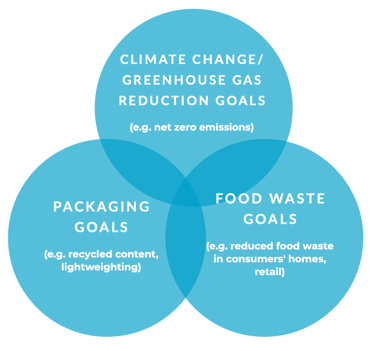 If a key takeaway remains from the information and statistics outlined above, it is that an enormous opportunity exists for properly designed and innovative packaging to help combat food waste. However, while this presents a chance for packaging to "do good," it must also be noted that designing packaging for food waste reduction should not be done in a vacuum, and should be considered along with other sustainability & recyclability goals and targets.
If a key takeaway remains from the information and statistics outlined above, it is that an enormous opportunity exists for properly designed and innovative packaging to help combat food waste. However, while this presents a chance for packaging to "do good," it must also be noted that designing packaging for food waste reduction should not be done in a vacuum, and should be considered along with other sustainability & recyclability goals and targets.
Packaging waste remains a top concern across the globe, and it is important to ensure that initiatives to improve recovery of plastic packaging waste and goals for food waste reduction are not at odds. For example, a packaging solution that extends shelf-life, but renders the packaging not recyclable may not be the best design choice if the packaging itself turns to waste at end of life.
Ultimately, the best innovations will take a holistic approach to packaging design, considering the entire product lifecycle and checking as many "boxes" as possible.
ICPG's Solution: The XPP Portfolio
In 2021, ICPG's XPP Enhanced Barrier Polypropylene was selected as a finalist in in the SPC Innovator Awards in the category of Innovation in Food Waste Prevention. This innovative patent-pending solution has since evolved into a portfolio of rigid packaging solutions that offer various levels of barrier protection while delivering on other sustainability, recyclability, processing and cost requirements so brands can find the perfect fit across a span of food applications:
- Barrier Protection: XPP solutions deliver a dramatic improvement to both the oxygen transmission rate (OTR) and the moisture vapor transmission rate (MVTR) in comparison to other commonly used thermoplastic materials - all without the use of specialty barrier materials, coatings or additives - presenting the opportunity to extend the shelf-life of packaged foods across three selections of barrier protection depending on application requirements:
-
- Enhanced Barrier: Suitable for refrigerated & short shelf-life applications providing:
- Up to 90/90% improvement in OTR/MVTR barrier protection vs traditional PP
- Over 100/150% improvement in OTR/MVTR barrier protection vs PS
- RE-BA: Suitable for medium-barrier and moderate shelf-life applications offering comparable OTR barrier protection to EVOH in thin-gauge applications
- High Barrier: Suitable for high-barrier and shelf-stable applications through a multi-layer coextruded structure with EVOH
- Enhanced Barrier: Suitable for refrigerated & short shelf-life applications providing:
-
- Sustainable: Produced from 100% polypropylene materials, our lightweight XPP solutions reduce material consumption, offer compatibility with the Polypropylene recycling stream (RIC #5), and result in a reduced carbon footprint compared to alternative solutions.
- Compatible: XPP is a high stiffness and low-shrink material solution - which means it behaves similar to PS during processing to offer process compatibility with existing thermoforming & FFS equipment and tooling. The advanced stiffness of our XPP materials mirrors PS to maintain the snap-ability and score-ability required of certain FFS applications.
- Economical: The low density & lightweight nature of our 100% polypropylene solutions means reduced material consumption, increased yield, and an overall reduced cost compared to PS & PET alternatives.
Interested in learning more about using XPP in your application? Download the XPP Product Sheet to explore the benefits of this material and talk with our team:



